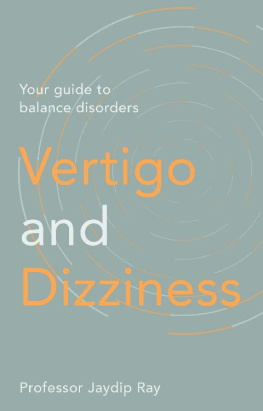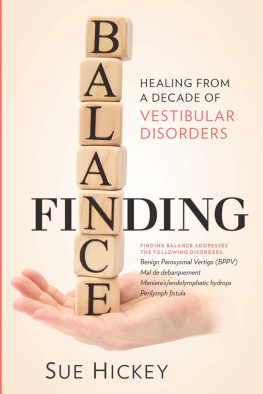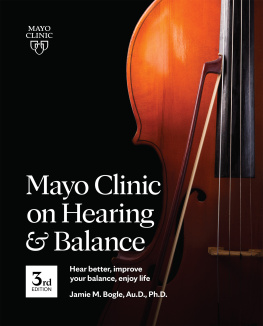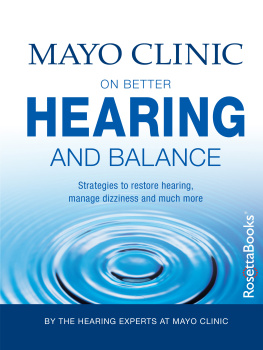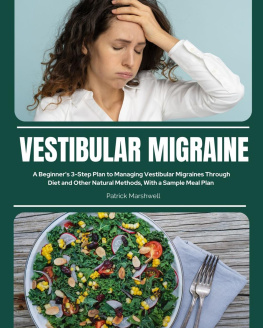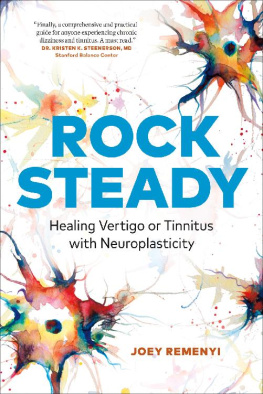Overcoming Common Problems
Vertigo and Dizziness
Your guide to balance disorders
PROFESSOR JAYDIP RAY
First published in Great Britain in 2018 by Sheldon Press
An Hachette UK Company
Sheldon Press
Carmelite House
50 Victoria Embankment
London EC4Y 0DZ
www.sheldonpress.co.uk
Copyright Professor Jaydip Ray 2018
The authors of the individual chapters included in this work have asserted their rights under the Copyright, Designs and Patents Act, 1988, to be identified as such.
All rights reserved. No part of this book may be reproduced or transmitted in any form or by any means, electronic or mechanical, including photocopying, recording, or by any information storage and retrieval system, without permission in writing from the publisher.
The author and publisher have made every effort to ensure that the external website and email addresses included in this book are correct and up to date at the time of going to press. The author and publisher are not responsible for the content, quality or continuing accessibility of the sites.
British Library Cataloguing-in-Publication Data
A catalogue record for this book is available from the British Library
ISBN 9781847094438
eBook ISBN 9781847094445
Typeset by Falcon Oast Graphic Art Ltd, www.falcon.uk.com
First printed in Great Britain by Ashford Colour Press
Subsequently digitally reprinted in Great Britain
eBook by Falcon Oast Graphic Art Ltd, www.falcon.uk.com
Produced on paper from sustainable forests
This book is dedicated to my parents, who have always inspired me to help others
Contents
Acknowledgements
I am most indebted to my family for their unwavering support in all my endeavours. Also to my teachers, trainees and, most importantly, my patients, from whom I continue to learn. My special thanks to David Baguley, Roger Gray, Julie Ward, Pam Shaw, David Throssell, Claire Shepherd and Hayley Skidmore for their continued support and guidance. I would also like to acknowledge the Sheldon team and the immense input of all the contributors, who are:
- Chapters 1 and 3 Simon Carr Consultant ENT Surgeon, Sheffield Childrens Hospital and Bradford Royal Infirmary
- Chapter 5 Panos A. Dimitriadis Academic Clinical Fellow in ENT, Sheffield Teaching Hospitals
- Chapter 11 Dev Bhattacharyya Consultant Neurosurgeon, Sheffield Teaching Hospitals
- Chapter 12 Dr Jo Sessions Clinical Psychologist, Regional Department of Neurotology, Sheffield Teaching Hospitals
- Chapter 13 Christopher Bowse Chief Technical Audiologist, Regional Department of Neurotology
Introduction
The fact that we walk on two legs, unlike the majority of animals, is often taken for granted. What we dont always appreciate, however, is the complexity of the processes that enable us to do this, and the fine alterations the body and brain are constantly making while maintaining our balance and posture. Very often, its only when things go wrong that we give much thought to the processes involved. This book examines how we keep our balance, how this apparently simple feat interlinks with other organs and systems in the body and the consequences when this delicate and intricate system fails. We look at the vexed question of dizziness, which affects so many people, and explain why a straightforward statement such as, I feel dizzy may actually beg more questions than it answers. Balance disorders cause a great deal of distress and confusion: in the UK, 5 out of every 1,000 people consult their GP each year because of vertigo, while 30 per cent of people report dizziness at some point.
Peoples vocabulary can be vague and subjective when it comes to describing these symptoms, however. Neither dizziness nor vertigo is a disease as such rather, both are symptoms. Dizziness in particular tends to be used as a catch-all, general term of reference, which is useful as a starting point but needs to be developed a lot more before it can mean anything medically reliable. We will examine in detail what constitutes dizziness and its unpleasant twin, vertigo, the differences between them and the various conditions they might indicate. Hopefully this will give you a clearer idea of what to tell your doctor if you need to make an appointment. On this point, some people fear that their symptoms indicate a little-known neurological disease that conventional tests fail to pick up. Dizziness and vertigo can indeed be baffling. Its important to realize, though, that they do often involve anxiety, which can affect a persons perception of his or her condition and have an impact on that persons quality of life in a more general way as well. So, this book also looks at psychological strategies to manage balance disorders. The main focus, however, is on physical diseases; we cover a wide range of balance disorders, including those that are little known and/or have only recently come under close investigation. This book also tells you what medical treatments you might expect for the various conditions, including lifestyle management, medication, implants and surgery. We also look at future research. Armed with all this information, you should, we hope, emerge with a much better understanding of balance disorders, although this book is not a substitute for your own doctors advice, which you should seek for proper diagnosis and treatment.
Lets start by looking at balance and posture, and the processes by which these remain stable.
1
Balance And Posture
Simon Carr
Balance is your ability to maintain the centre of gravity of your body within its base of support, whereas posture is defined as the alignment of your body and limbs. There are several types of posture: static (standing, sitting and lying, for example) and dynamic (such as walking, running and lifting). It is during movements that the balance system is under the most strain.
By design, the human body is a rather unstable machine. Due to the fact that two-thirds of our mass is located in the top two-thirds of the body, furthest from the ground, we are in a constant state of instability and, therefore, reliant on a balance system that is constantly assessing information coming in and adjusting our positioning as a result. This is most apparent when an aspect of the balance system fails, making falls more likely.
Maintenance of your posture and balance relies on the inter- action of several different systems, including your eyes (ocular sys- tem), inner ears (vestibular system), and joints, especially of your legs (proprioceptive system), which interact to sense the environ- ment. The information from these systems then travels to the bal- ance centre of your brain with messages from your joints travelling via the spinal cord, where it is processed. When it reaches your brain, the information from the different systems is pieced together and an appropriate response of the eyes, muscles and joints is performed, all of which take place in a fraction of a second.
Eyes (ocular system)
The eyes play a major role and vision is arguably the most important sense for maintaining your balance. Your vision is constantly assessing the surrounding environment that you are either standing in or moving on and the nature of objects around you, the information being fed back to the balance centre in your brain.
Inner ears (vestibular system)
The role of your inner ears is to assess movements of your head relative to gravity and the horizon and enable you to keep looking at an object even when your head moves in different directions.
Your inner ears are made up of three semicircular canals and two otolithic (ear stones) organs. The three semicircular canals in each inner ear lie within three different planes: one lateral (horizontal), one posterior (backmost) and one superior (uppermost). They work in pairs: the lateral canals work together and the superior canal works with the opposite posterior canal. The canals are fluid-filled and have an enlarged (ampullated) end, which contains the sense organ (cupula), a jelly-like dome-shaped structure with hair cells protruding into it which are attached to the balance nerve. When you turn your head, the fluid in the canals shifts, which causes the cupula to move, thus moving the hair cells and triggering a signal that travels along the balance nerve. This in- formation is used by your balance centre to tell the brain where the head is positioned in relation to the environment that is, if the head is tilted or turned to the left or right or looking up or down. This information is used to keep your eyes looking at a particular object when your head is turning and also to enable your eyes to remain stable when your head moves while you are walking or running.
Next page
